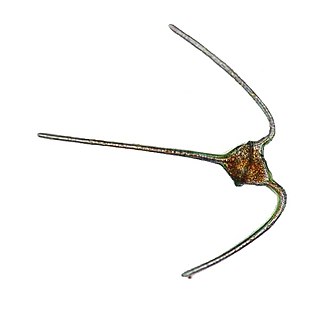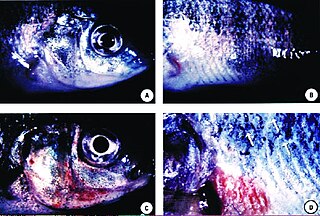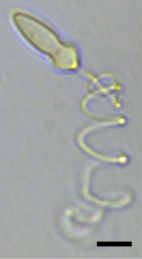
Pfiesteria piscicida is a dinoflagellate species of the genus Pfiesteria that some researchers claim was responsible for many harmful algal blooms in the 1980s and 1990s on the coast of North Carolina and Maryland. North Carolinian media in the 1990s referred to the organism as the cell from hell. It is known to populate estuaries. Piscicida means "fish-killer".
Ciguatera fish poisoning (CFP), also known as ciguatera, is a foodborne illness caused by eating reef fish contaminated with ciguatoxins. Such individual fish are said to be ciguatoxic. Symptoms may include diarrhea, vomiting, numbness, itchiness, sensitivity to hot and cold, dizziness, and weakness. The onset of symptoms varies with the amount of toxin eaten. If a lot of toxins are consumed symptoms may appear within half an hour. If a low amount of toxins are consumed symptoms make take a few days to appear. Diarrhea may last up to four days. Symptoms may last a few weeks to a few months. Heart problems such as slow heart rate and low blood pressure may occur.

The genus Ceratium is restricted to a small number of freshwater dinoflagellate species. Previously the genus contained also a large number of marine dinoflagellate species. However, these marine species have now been assigned to a new genus called Tripos. Ceratium dinoflagellates are characterized by their armored plates, two flagella, and horns. They are found worldwide and are of concern due to their blooms.

Predatory dinoflagellates are predatory heterotrophic or mixotrophic alveolates that derive some or most of their nutrients from digesting other organisms. About one half of dinoflagellates lack photosynthetic pigments and specialize in consuming other eukaryotic cells, and even photosynthetic forms are often predatory.

Gambierdiscus toxicus is a species of photosynthetic unicellular eukaryote belonging to the Alveolata, part of the SAR supergroup. It is a dinoflagellate which can cause the foodborne illness ciguatera, and is known to produce several natural polyethers including ciguatoxin, maitotoxin, gambieric acid, and gambierol. The species was discovered attached to the surface of brown macroalgae.

Karenia is a genus that consists of unicellular, photosynthetic, planktonic organisms found in marine environments. The genus currently consists of 12 described species. They are best known for their dense toxic algal blooms and red tides that cause considerable ecological and economical damage; some Karenia species cause severe animal mortality. One species, Karenia brevis, is known to cause respiratory distress and neurotoxic shellfish poisoning (NSP) in humans.
Luciella masanensis is a species of heterotrophic marine dinoflagellates.
Gambierdiscus belizeanus is a species of dinoflagellate, first found in Belize.
Gambierdiscus pacificus is a species of toxic dinoflagellate. It is 67–77 μm long and 60–76 μm wide dorsoventrally and its surface is smooth. It is identified by a four-sided apical pore plate surrounded by 30 round pores. Its first plate occupies 20% of the width of the hypotheca.
Gambierdiscus australes is a species of toxic dinoflagellate. It is 76–93 μm long and 65–85 μm wide dorsoventrally and its surface is smooth. It is identified by a broad ellipsoid apical pore plate surrounded by 31 round pores. Its first plate occupies 30% of the width of the hypotheca.
Gambierdiscus polynesiensis is a species of toxic dinoflagellate. It is 68–85 μm long and 64–75 μm wide dorsoventrally and its surface is smooth. It is identified by a large triangular apical pore plate, a narrow fish-hook opening surrounded by 38 round pores, and a large, broad posterior intercalary plate. Its first plate occupies 60% of the width of the hypotheca.
Gambierdiscus caribaeus is a species of toxic dinoflagellate, which among others causes ciguatera fish poisoning. It is photosynthetic and epibenthic.
Gambierdiscus carolinianus is a species of toxic dinoflagellate, which among others causes ciguatera fish poisoning. It is photosynthetic and epibenthic.
Gambierdiscus carpenteri is a species of toxic dinoflagellate, which among others causes ciguatera fish poisoning. It is photosynthetic and epibenthic.
Gambierdiscus ruetzleri is a species of toxic dinoflagellates, which among others causes ciguatera fish poisoning. It is photosynthetic and epibenthic.

Polykrikos is one of the genera of family Polykrikaceae that includes athecate pseudocolony-forming dinoflagellates. Polykrikos are characterized by a sophisticated ballistic apparatus, named the nematocyst-taeniocyst complex, which allows species to prey on a variety of organisms. Polykrikos have been found to regulate algal blooms as they feed on toxic dinoflagellates. However, there is also some data available on Polykrikos being toxic to fish.

Ostreopsis is a genus of free-living dinoflagellates found in marine environments. Some species are benthic; the planktonic species in the genus are known for the toxic algal blooms that they sometimes cause, threatening human and animal health.
Mireille Chinain is a marine scientist from French Polynesia.
Coolia is a marine dinoflagellate genus in the family Ostreopsidaceae. It was first described by Meunier in 1919. There are currently seven identified species distributed globally in tropical and temperate coastal waters. Coolia is a benthic or epiphytic type dinoflagellate: it can be found adhered to sediment or other organisms but it is not limited to these substrates. It can also be found in a freely motile form in the water column. The life cycle of Coolia involves an asexual stage where the cell divides by binary fission and a sexual stage where cysts are produced. Some of the species, for example, Coolia tropicalis and Coolia malayensis, produce toxins that can potentially cause shellfish poisoning in humans.
Ciguatoxin 1 or CTX-1 is a toxic chemical compound, the most common and potent type in the group of ciguatoxins. It is a large molecule consisting of polycyclic polyethers that can be found in certain types of fish in the Pacific Ocean. The compound is produced by Dinoflagellates Gambierdiscus toxicus and is passed on through the food chain by fish. The compound has no effect in fish but is toxic to humans.







